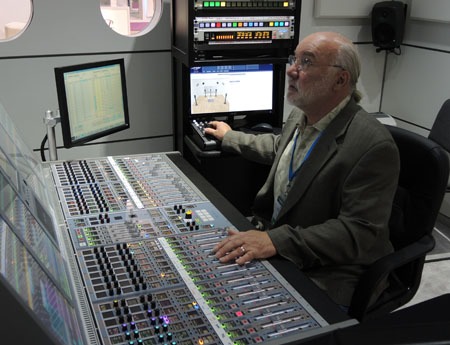Looking to Lift the Sound Bar

At first glance, immersive sound systems would seem to be an easy sell for audiophiles and wealthy home theater enthusiasts, but a much tougher one for broadcasters and average consumers.
The technology promises, after all, to take audio to a whole new spatial dimension, with sound coming from all parts of the room, seemingly setting the viewer in the middle of a movie or sporting event. Even better, these so-called immersive or “object-oriented” sound systems would make it possible for users to personalize or interact with their audio experience, more easily turning up the volume of the announcer or some other object that is part of the sound mix.
But the traditional way of achieving these effects requires the installation of a number of new speakers in the home, including some mounted on the ceiling. “If you want to go all the way with discrete speakers hanging above you and around in you various locations in the room, that is a narrower market,” said Jeff Riedmiller, senior director, sound group, office of the CTO, at Dolby Laboratories.
But Riedmiller and others stress that the new audio systems have a number of immediate advantages for broadcasters, adding that those systems will have a much wider appeal among consumers who can’t afford high-end audio systems.
SUMMER OF ATSC
Those advantages are so compelling that the members of the Advanced Television Systems Committee are considering both the AC-4 system from Dolby and the MPEG-H technology that is backed by Fraunhofer IIS, Qualcomm Technologies and Technicolor for the new ATSC 3.0 standard. A decision on which system will be included is expected this summer.
While ATSC 3.0 will require major changes to existing broadcast infrastructures, the new audio systems can be implemented without extensive changes to existing equipment, proponents say. “The advantage of MPEG-H is that it gives broadcasters a great deal of flexibility in how they adopt it,” as well as some immediate advantages, said Robert Bleidt, general manager of the audio and multimedia division of Fraunhofer IIS, which supplies the audio technology used in broadcast standards by many countries outside the U.S.
Broadcasting & Cable Newsletter
The smarter way to stay on top of broadcasting and cable industry. Sign up below
At the recent NAB show, Fraunhofer conducted several demos of the system, including producing immersive audio for a live sports event using a traditional remote production truck. For that demo, they only had to add a few additional microphones, a new monitoring unit from Junger Audio and some speakers. “The investment in existing broadcasting equipment is preserved when you go to MPEG-H,” Bleidt said. “They won’t have to buy new consoles and retrain staff on how to control and monitor the audio.”
Riedmiller at Dolby added that the transition to their Atmos immersive audio system has been relatively easy for the Hollywood studios for high-end films. “They are now natively mixing in Atmos and then deriving the channel-based deliverables from it,” he said.
Importantly, the new audio systems will provide an immediate payback in streamlined operations in loudness monitoring, accessibility and workflows for those broadcasters who aren’t planning to deliver immersive audio. “There is a big payback in simplifying day-to-day operations,” Riedmiller said.
That’s also good news for producers. Bleidt noted that currently many consumers use stereo soundbars, which have poorer audio quality than the home theater 5.1 surround sound systems that were more widely used in the 1990s. “The spatial quality of TV audio has actually gone down in the 21st century,” Bleidt said.
To help reverse that, Fraunhofer demoed a new soundbar at NAB that provides immersive sound. “We very much believe that in a year or two consumers will be able to buy a 3D soundbar and get good immersive sound,” Bleidt said.
Immersive sound could also make its way into the home without elaborate speaker systems via mobile devices and virtual reality. Both systems are capable of providing immersive sound over traditional ear buds for mobile users, and Samsung has licensed MPEG-H for its Gear VR system. “There is also technology built into MPEG-H that allows us to tailor the sound for the device being used,” which could greatly improve the generally poor sound currently produced by smartphones and tablets, Bleidt added.
